Numerical Analysis of Thermal Impact between the Cooling Facility and the Ground
Abstract
1. Introduction
2. Materials and Methods
2.1. Description of the Facility and the Measuring Apparatus
2.2. Numerical Analysis—Assumptions for Calculations
- Selection of the values of technical parameters for the ground and external partitions of the cooling facility;
- Adoption of a six-month period preceding the relevant calculation period, which eliminated the initial error;
- Determination of the values of the ventilation and air infiltration streams;
- Conduct of a simulation of cases where a constant ground temperature was assumed at a depth of 10 m below the cooling facility;
- Determination of the initial temperature of the ground;
- Verification of the conformity of the theoretical data obtained with the actual data.
3. Results
3.1. Validation of the Calculation Model
3.2. Heat Exchange with the Ground and Energy Management of the Cooling Facility
3.3. Thermal Interaction with Ground
4. Discussion
5. Conclusions
Author Contributions
Funding
Conflicts of Interest
References
- Albanese, D.; Cinquanta, I.; Di Matteo, M. Effects of an innovative dipping treatment on the cold storage of minimally processed Annurca apples. Food Chem. 2007, 105, 1054–1060. [Google Scholar] [CrossRef]
- Sokolowski, P.; Nawalany, G. Numerical Analysis of the Impact of the Cooling Cycle Length in Vegetable Cold Stores on the Heat Exchange with Soil. J. Ecol. Eng. 2019, 20, 162–170. [Google Scholar] [CrossRef]
- Olveira-Bouzasa, V.; Pita-Calvo, C.; Vázquez-Odériz, M.L.; Romero-Rodríguez, M.A. Evaluation of a modified atmosphere packaging system in pallets to extend the shelf-life of the stored tomato at cooling temperature. Food Chem. 2021, 364, 130309. [Google Scholar] [CrossRef]
- Sokolowski, P.; Nawalany, G. Experimental study of the impact of the vegetable cold store floor location on heat exchange with the soil. Appl. Ecol. Environ. Res. 2019, 17, 8179–8189. [Google Scholar] [CrossRef]
- Ali, S.; Khan, A.; Malik, A.U.; Anjum, M.A.; Nawaz, A.; Shoaib Shah, H.M. Modified atmosphere packaging delays enzymatic browning and maintains quality of harvested litchi fruit during low temperature storage. Sci. Hortic. 2019, 254, 14–20. [Google Scholar] [CrossRef]
- Nincevic, G.; Djakovic, A.; Bosiljkov, S.; Halambek, T.; Zoric, J.; Dragovic-Uzelac, Z.; Rimac, V.; Brncic, S. Valorisation of tomato peel waste as a sustainable source for pectin, polyphenols and fatty acids recovery using sequential extraction. Waste Biomass Valorization 2020, 11, 4593–4611. [Google Scholar] [CrossRef]
- Sokolowski, P.; Nawalany, G. Analysis of Energy Exchange with the Ground in a Two-Chamber Vegetable Cold Store, Assuming Different Lengths of Technological Break, with the Use of a Numerical Calculation Method—A Case Study. Energies 2020, 13, 4970. [Google Scholar] [CrossRef]
- Ambaw, A.; Delele, M.A.; Defraeye, T.; Ho, Q.T.; Opara, L.U.; Nicolai, B.M.; Verboven, P. The use of CFD to characterize and design post-harvest storage facilities: Past, present and future. Comput. Electron. Agric. 2013, 93, 184–194. [Google Scholar] [CrossRef]
- Jakubowski, T.; Krolczyk Jolanta, B. Method for the reduction of natural losses of potato tubers during their long-term storage. Sustainability 2020, 12, 1048. [Google Scholar] [CrossRef]
- Mazzeo, T.; Paciulli, M.; Chiavaro, E.; Visconti, A.; Pellegrini, N. Impact of the industrial freezing process on selected vegetables—Part II. Colour and bioactive compounds. Food Res. Int. 2015, 75, 89–97. [Google Scholar] [CrossRef] [PubMed]
- Nawalany, G.; Sokołowski, P. Impact of Selected Technical Soil Parameters on the Greenhouse Energy Management. J. Ecol. Eng. 2019, 20, 245–252. [Google Scholar] [CrossRef]
- Zhao, B. Study on heat transfer of ground heat exchanger based on wedge let finite element method. Int. Commun. Heat Mass Transf. 2016, 74, 63–68. [Google Scholar] [CrossRef]
- Kim, H.K.; Kang, G.C.; Moon, J.P.; Lee, T.S.; Oh, S.S. Estimation of Thermal Performance and Heat Loss in Plastic Greenhouses with and without Thermal Curtains. Energies 2018, 11, 578. [Google Scholar] [CrossRef]
- Akkurt, G.G.; Aste, N.; Borderon, J.; Buda, A.; Calzolari, M.; Chung, D.; Costanzo, V.; Del Pero, C.; Evola, G.; Huerto-Cardenas, H.E.; et al. Dynamic thermal and hygrometric simulation of historical buildings: Critical factors and possible solutions. Renew. Sustain. Energy Rev. 2020, 118, 109509. [Google Scholar] [CrossRef]
- Majidi, H.; Minaei, S.; Almassi, M.; Mostofi, Y. Tomato quality in controlled atmosphere storage, modified atmosphere packaging and cold storage. J. Food Sci. Technol. 2014, 51, 2155–2161. [Google Scholar] [CrossRef]
- Nawalany, G.; Lendelova, J.; Sokołowski, P.; Zitnak, M. Numerical Analysis of the Impact of the Location of a Commercial Broiler House on Its Energy Management and Heat Exchange with the Ground. Energies 2021, 14, 8565. [Google Scholar] [CrossRef]
- Kharseh, M.; Altorkmany, I. How global warming and building envelope will change energy use in central Europe. Appl. Energy 2012, 97, 999–1004. [Google Scholar] [CrossRef]
- Verboven, P.; Flick, D.; Nicolai, B.M.; Alvarez, G. Modeling transport phenomena in refrigerated food bulks, packages and stacks: Basics and advanced. Int. J. Refrig. 2006, 29, 985–997. [Google Scholar] [CrossRef]
- Nawalany, G.; Sokołowski, P. Building–Soil Thermal Interaction: A Case Study. Energies 2019, 12, 2922. [Google Scholar] [CrossRef]
- Kaushal, K.G.; Ramesh, S.; Anantha, K.H.; Singh, A.K.; Akuraju, V.R.; Barron, J.; Dev, I.; Tewari, R.K.; Wani, S.P.; Dhyani, S.K.; et al. Building climate resilience in degraded agricultural landscapes through water management: A case study of Bundelkhand region, Central India. J. Hydrol. 2020, 591, 125592. [Google Scholar]
- Zou, S.; Li, H.; Liu, L.; Wang, S.; Zhang, X.; Zhang, G. Experimental study on fire resistance improvement of wheat straw composite insulation materials for buildings. J. Build. Eng. 2021, 43, 103172. [Google Scholar] [CrossRef]
- Winkler, M.; Antretter, F.; Radon, J. Critical discussion of a shading calculation method for low energy building and passive house design. Energy Procedia 2017, 132, 33–38. [Google Scholar] [CrossRef]
- Xu, G.; Hu, L.; Luo, Y.; Tian, Z.; Deng, J.; Yuan, G.; Fan, J. Numerical modeling and parametric analysis of thermal performance for the large-scale seasonal thermal energy storage. Energy Build. 2022, 275, 112459. [Google Scholar] [CrossRef]
- Federico, B.; Giovanni, P.; Andrea, G. A shoeboxing algorithm for Urban Building Energy Modeling: Validation for stand-alone buildings. Sustain. Cities Soc. 2022, 104305. [Google Scholar] [CrossRef]
- Larwa, B.; Kupiec, K. Heat transfer in the ground with a horizontal heat exchanger installed—Long-term thermal effects. Appl. Therm. Eng. 2020, 164, 114539. [Google Scholar] [CrossRef]
- Chow, T.; Long, H.; Mok, H.Y.; Li, K.W. Estimation Of soil temperature profile in Hong Kong from climatic variables. Energy Build. 2011, 43, 3568–3575. [Google Scholar] [CrossRef]
- Zhang, Z.; Sun, D.W. Effect of cooling methods on the cooling efficiencies and qualities of cooked broccoli and carrot slices. J. Food Eng. 2006, 77, 320–326. [Google Scholar] [CrossRef]
- Nawalany, G.; Sokolowski, P. Analysis of hygrothermal conditions of external partitions in an underground fruit store. J. Ecol. Eng. 2016, 17, 75–82. [Google Scholar] [CrossRef]
- Maia, J.; Ramos, N.M.M.; Veiga, R. Evaluation of the hygrothermal properties of thermal rendering systems. Build. Environ. 2018, 144, 437–449. [Google Scholar] [CrossRef]
- Chanchangi, Y.N.; Ghosh, A.; Sundaram, S.; Mallick, T.K. An analytical indoor experimental study on the effect of soiling on PV, focusing on dust properties and PV surface material. Sol. Energy 2020, 203, 46–68. [Google Scholar] [CrossRef]
- Nawalany, G.; Sokolowski, P. Numerical Analysis of the Effect of Ground Dampness on Heat Transfer between Greenhouse and Ground. Sustainability 2021, 13, 3084. [Google Scholar] [CrossRef]
- Chuah, J.W.; Raghunathan, A.; Jha, N.K. ROBESim: A retrofit-oriented building energy simulator based on EnergyPlus. Energy Build. 2013, 66, 88–103. [Google Scholar] [CrossRef]
- Crawley, D.B.; Lawrie, L.K.; Winkelmann, F.C.; Buhl, W.; Huang, Y.J.; Pedersen, C.O.; Strand, R.K.; Liesen, R.J.; Fisher, D.E.; Witte, M.J.; et al. EnergyPlus: Creating a new-generation building energy simulation program. Energy Build. 2001, 33, 319–331. [Google Scholar] [CrossRef]
- Künzel, H.M.; Radoń, J. Building envelope design by hygrothermal simulations—Experience and guidelines. Build. Phys. Theory Pract. 2005, 1, 230–238. [Google Scholar]
- Gielzecki, J.; Jakubowski, T. The Simulation of Temperature Distribution in a Ground Heat Exchanger-GHE Using the Autodesk CFD Simulation Program. In Proceedings of the 4th International Conference on Renewable Energy Sources (ICORES), Nagoya, Japan, 19–21 September 2018. [Google Scholar]
- Ahmad, T.; Chen, H.; Guo, Y.; Wang, J. A comprehensive overview on the data driven and large scale based approaches for forecasting of building energy demand: A review. Energy Build. 2018, 165, 301–320. [Google Scholar] [CrossRef]
- Catrini, P. Improving energy efficiency of commercial buildings by combined heat cooling and power plants. Sustain. Cities Soc. 2020, 60, 102157. [Google Scholar] [CrossRef]
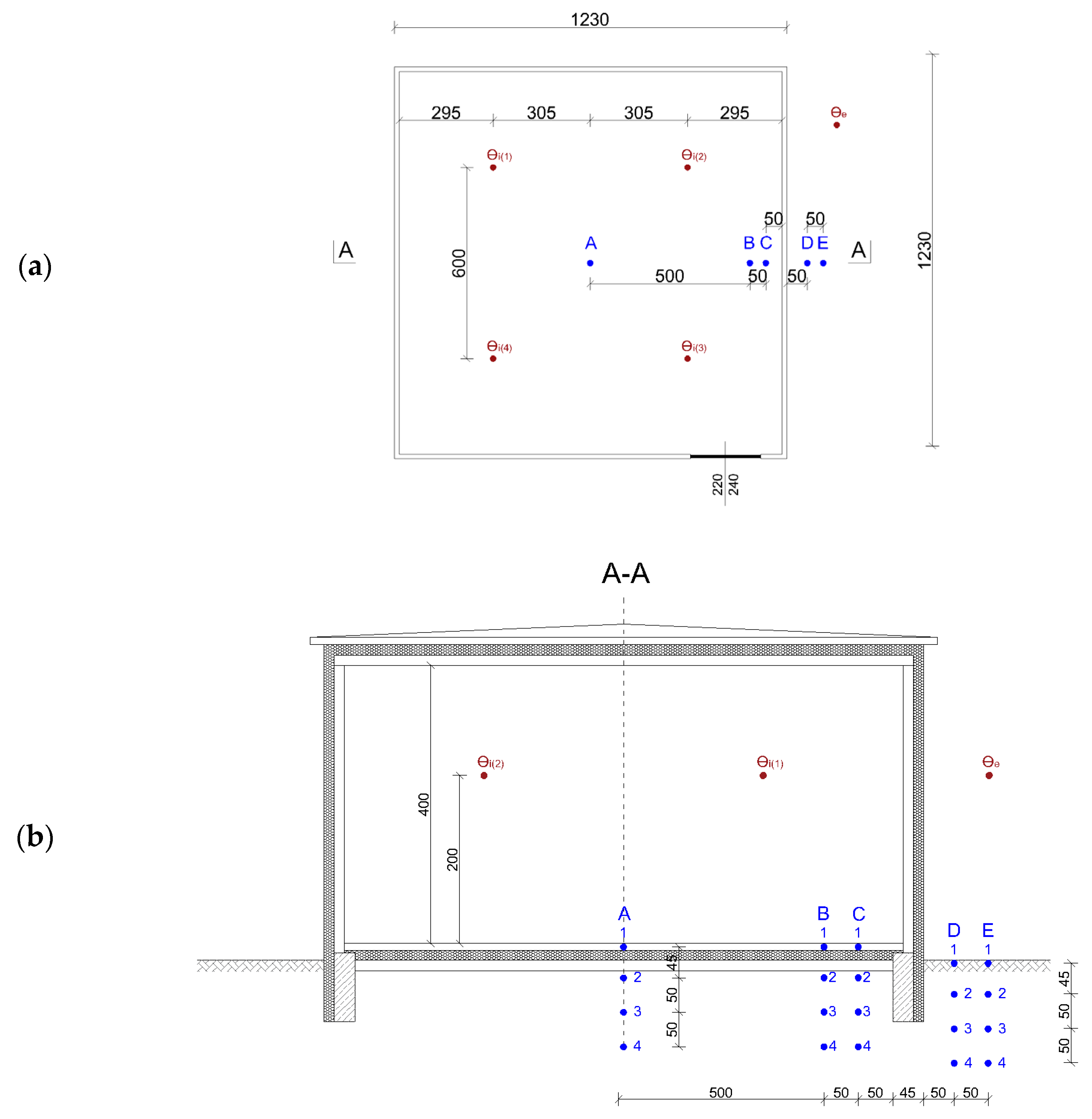


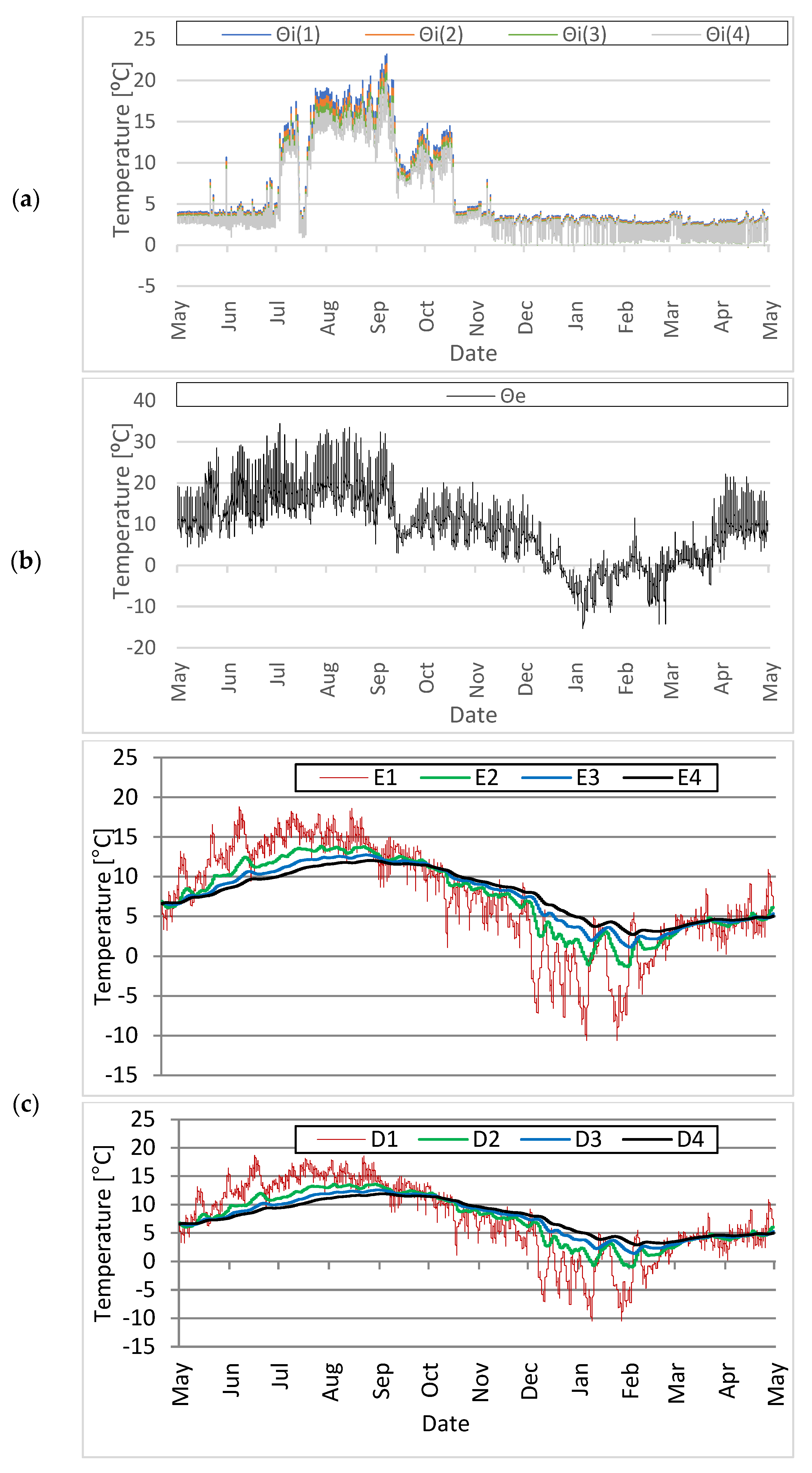
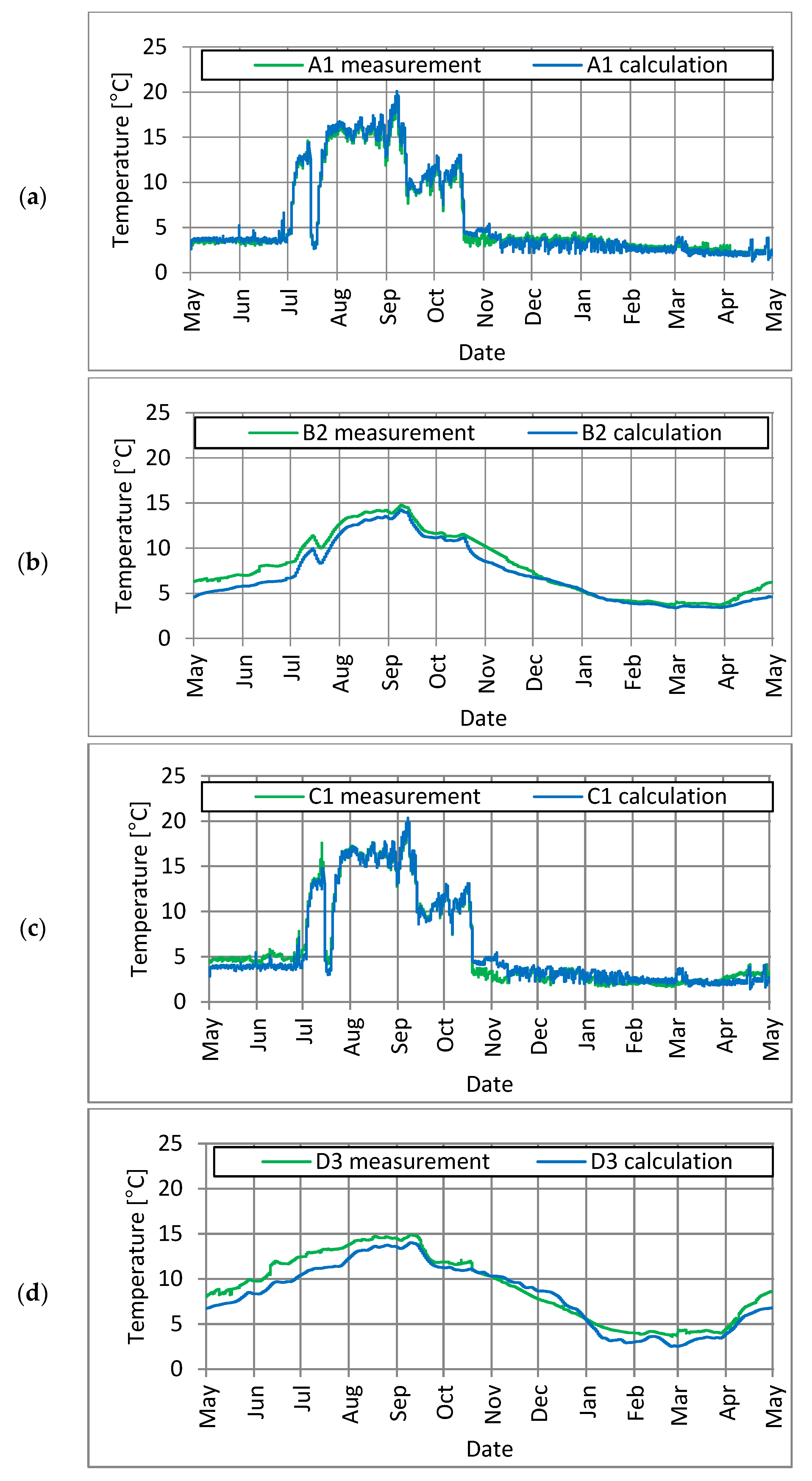
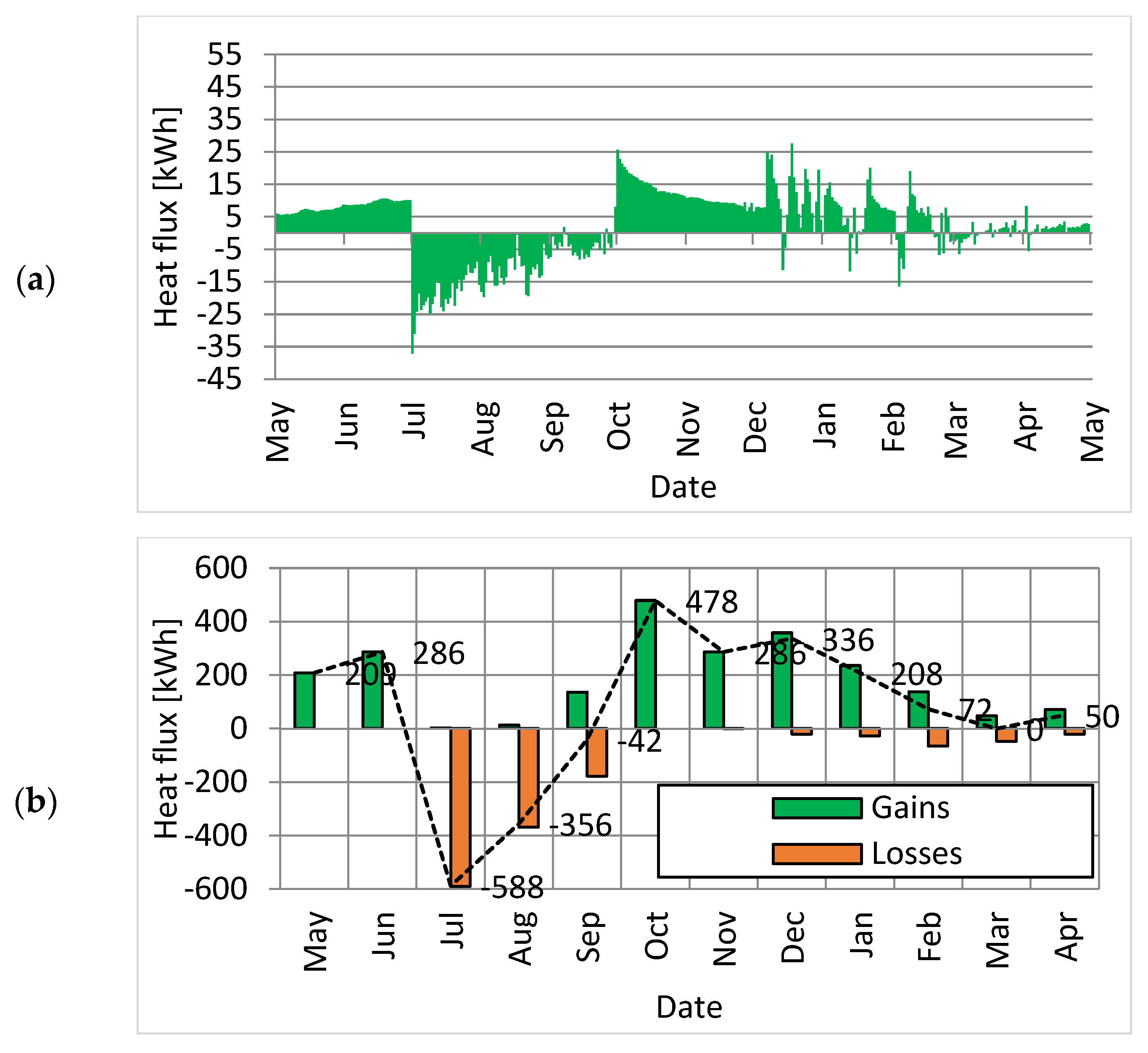
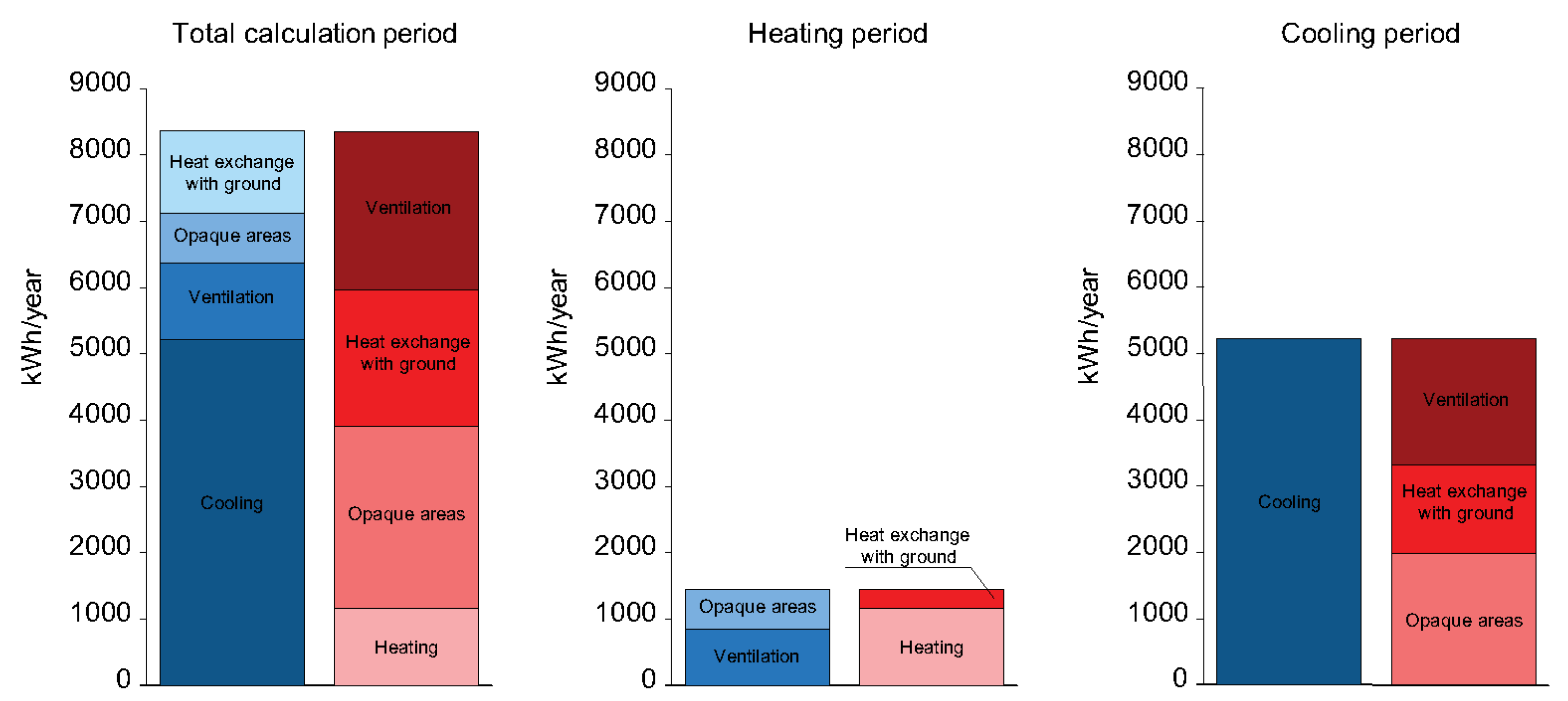
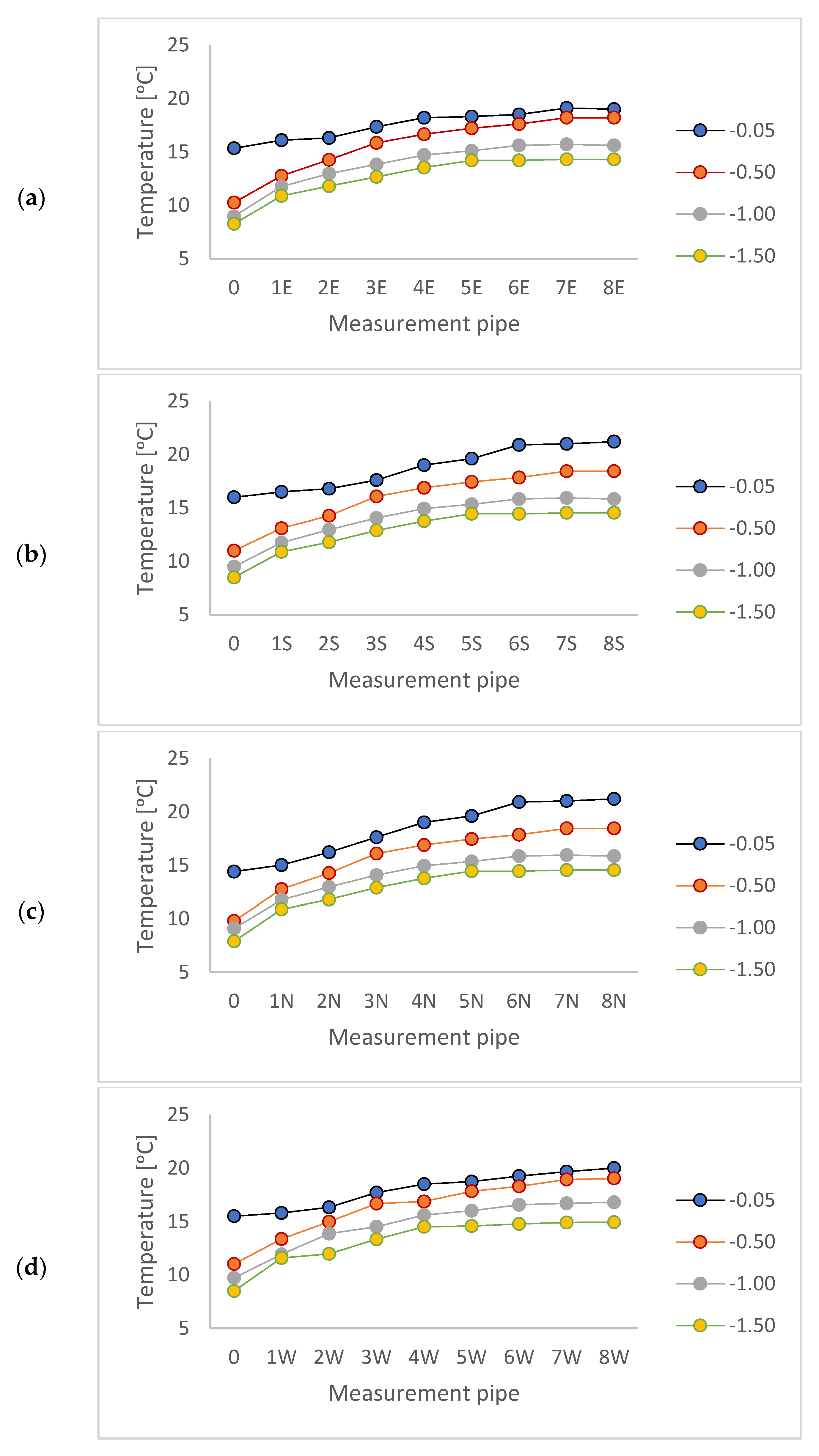

| Specification | Unit | Value | |
|---|---|---|---|
| Clay | density | kg·m−3 | 1600 |
| specific heat | J·kg−1·K−1 | 1000 | |
| thermal conductivity coefficient | W·m−1·K−1 | 1.8 | |
| Humus | density | kg·m−3 | 1800 |
| specific heat | J·kg−1·K−1 | 1260 | |
| thermal conductivity coefficient | W·m−1·K−1 | 0.9 | |
| Styrofoam | density | kg·m−3 | 20 |
| specific heat | J·kg−1·K−1 | 1500 | |
| thermal conductivity coefficient | W·m−1·K−1 | 0.04 | |
| Concrete | density | kg·m−3 | 2300 |
| specific heat | J·kg−1·K−1 | 1000 | |
| thermal conductivity coefficient | W·m−1·K−1 | 2.3 | |
| Gravel bedding | density | kg·m−3 | 1800 |
| specific heat | J·kg−1·K−1 | 840 | |
| thermal conductivity coefficient | W·m−1·K−1 | 0.9 | |
| Steel | density | kg·m−3 | 7900 |
| specific heat | J·kg−1·K−1 | 460 | |
| thermal conductivity coefficient | W·m−1·K−1 | 17 | |
Publisher’s Note: MDPI stays neutral with regard to jurisdictional claims in published maps and institutional affiliations. |
© 2022 by the authors. Licensee MDPI, Basel, Switzerland. This article is an open access article distributed under the terms and conditions of the Creative Commons Attribution (CC BY) license (https://creativecommons.org/licenses/by/4.0/).
Share and Cite
Sokołowski, P.; Nawalany, G.; Jakubowski, T.; Popardowski, E.; Lopushniak, V.; Atilgan, A. Numerical Analysis of Thermal Impact between the Cooling Facility and the Ground. Energies 2022, 15, 9338. https://doi.org/10.3390/en15249338
Sokołowski P, Nawalany G, Jakubowski T, Popardowski E, Lopushniak V, Atilgan A. Numerical Analysis of Thermal Impact between the Cooling Facility and the Ground. Energies. 2022; 15(24):9338. https://doi.org/10.3390/en15249338
Chicago/Turabian StyleSokołowski, Paweł, Grzegorz Nawalany, Tomasz Jakubowski, Ernest Popardowski, Vasyl Lopushniak, and Atilgan Atilgan. 2022. "Numerical Analysis of Thermal Impact between the Cooling Facility and the Ground" Energies 15, no. 24: 9338. https://doi.org/10.3390/en15249338
APA StyleSokołowski, P., Nawalany, G., Jakubowski, T., Popardowski, E., Lopushniak, V., & Atilgan, A. (2022). Numerical Analysis of Thermal Impact between the Cooling Facility and the Ground. Energies, 15(24), 9338. https://doi.org/10.3390/en15249338







